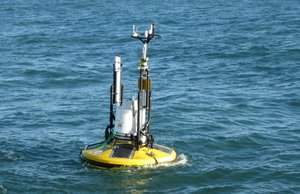Vineyard Wind announced that it will deploy a wind measurement and oceanographic buoy within the project area of its proposed 800 megawatt (MW) offshore wind project, which is located 14 miles south of Martha’s Vineyard.

The buoy will measure a number of parameters, including wind speed. Photo courtesy of Vineyard Wind.
The buoy will measure a number of parameters, including wind speed at different heights above the water, wave heights and frequency, and ocean currents, to aid in the final design of Vineyard Wind’s generating station.
Deployment of a SEAWATCH Wind LiDAR Buoy, also commonly known as “FLIDAR buoy,” on May 22nd will allow low power laser technology to measure wind speeds with high precision over a range of altitudes above the instrument. The buoy was designed and built by Fugro, a global leader in offshore services, offshore science, and working ships design. Fugro will also operate the buoy over the course of its deployment.
Mounted on the top of the buoy, FLIDAR is commonly used at airports and on commercial airliners to detect wind shear.
“Placement of the wind measurement buoy marks another step forward in development of the Vineyard Wind project,” said Erich Stephens, Chief Development Officer for Vineyard Wind. “Deployment of this measurement equipment is an important part of our plan to obtain permits, finalize the project design, and begin construction in 2019, so that we can be fully operational in 2021.”
Vineyard Wind’s FLIDAR buoy will be deployed by the tug boat Kodiak, which is owned and operated by the company 41°North Offshore and is based on Fish Island in New Bedford Harbor.
“We’re excited to be taking part in the Vineyard Wind project at the beginning of the offshore wind industry here in New Bedford,” said Captain Matthew Fisher, owner and managing partner of 41°North Offshore, who will captain the Kodiak during the FLIDAR deployment.
Further details on the location of the buoy, and navigational aids, can be found in the Notice to Mariners that Vineyard Wind submitted to the Coast Guard.
Vineyard Wind, which recently filed a Draft Environmental Impact Report (DEIR) with the Massachusetts Environmental Policy Act (MEPA) Office, initiated its federal, state, and local permitting review process in 2017, putting Vineyard Wind well ahead of any other proposed US offshore wind project in the permitting process. Vineyard Wind’s advanced permitting status positions the project to become the first commercial large-scale offshore wind farm in the United States, which will soon deliver significant economic development and clean energy benefits to residents and businesses in the Commonwealth.
The Vineyard Wind offshore wind turbine array, located in the federal waters 14 miles south of Martha’s Vineyard and approximately 34 miles south of the Cape Cod mainland, will be connected to the Massachusetts electrical grid by way of the Vineyard Wind Connector. The Vineyard Wind Connector consists of subsea and subsurface electrical transmission lines and a new substation that will connect the Vineyard Wind turbine array to the Massachusetts electric grid at an existing substation in an industrial park in Barnstable. No changes to the existing electrical transmission will be needed.
Vineyard Wind has stipulated that they will use solid material cables only, and that the cables will be buried for their entire length onshore, and also that the transformers and other electrical equipment at the new substation will be underlain by full volume, impervious containment systems.
Vineyard Wind is the only proposed commercial large-scale offshore wind farm in Massachusetts that has begun the process of obtaining required state and federal permits. It seeks to deliver the significant economic development and clean energy benefits of offshore wind to residents and businesses in the Commonwealth beginning in 2021.
In addition to the federal and state permitting reviews, the project is actively consulting with tribal and local agencies, including the Conservation Commission and Planning Boards of the Towns of Barnstable and Yarmouth. The project will also be reviewed by the Cape Cod Commission.
In total the Vineyard Wind project will face substantial public review and consultations by nearly 30 federal, tribal, state, and local approval agencies, including from the Army Corps of Engineers, National Marine Fisheries Service, the Massachusetts Energy Facilities Siting Board, Massachusetts DEP and CZM, the Cape Cod Commission and local conservation commissions.
Source: Company Press Release
